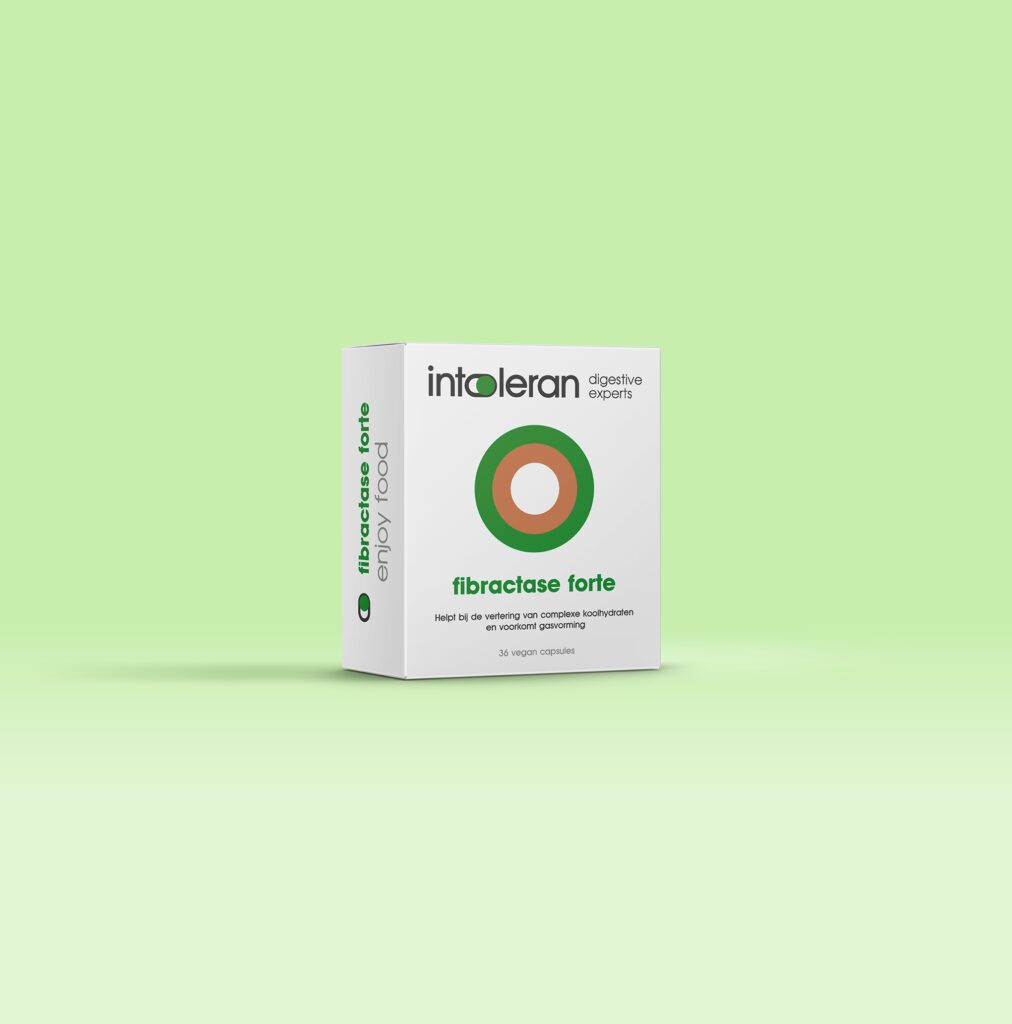FODMAP is a collective name for several types of carbohydrates that are difficult to digest. For some people, FODMAPs pose a risk of gas formation in the intestines. Read more about FODMAPs here.
what are FODMAPs?
FODMAP stands for Fermentable Oligosaccharides, Disaccharides, Monosaccharides and Polyols. FODMAPs are carbohydrates (saccharides) that are poorly absorbed or not absorbed at all in the small intestine and therefore end up in the large intestine. There, bacteria start breaking them down or fermenting them. During the fermentation process, gas can be released and water can be attracted.
For some people, FODMAPs are a risk factor for gas formation in the intestines.
Oligosaccharides are multiple carbohydrates consisting of 3 to 9 carbohydrate molecules. Within the FODMAP group of oligosaccharides, we know two different types: fructo-oligosaccharides and galacto-oligosaccharides, or fructans and galactans. Fructans and galactans occur naturally in various fruits and vegetables and in cereal products, legumes, and nuts.
Disaccharides are sugars composed of two carbohydrate molecules. Within the FODMAP group of disaccharides, we know lactose, also known as milk sugar. Lactose is a sugar mainly found in milk, other dairy products, and in processed foods.
Monosaccharides are simple sugars composed of one carbohydrate molecule. Within the FODMAP group of monosaccharides, we know fructose, also known as fruit sugar. Fructose occurs naturally in various fruits and vegetables and is added as a sweetener to many processed foods.
Polyols are sugar alcohols and are also called non-intensive sweeteners. Within the FODMAP group of polyols, we are familiar with sorbitol, mannitol, and xylitol, for example. Most polyols are added as sweeteners to processed (sugar-free) foods. In addition, they occur naturally in certain fruits and vegetables.
which foods contain FODMAPs?
FODMAPs occur naturally in various fruits and vegetables and are also added as sweeteners in many processed foods. Below, we have indicated for each FODMAP saccharide in which foods you find them. There is also a low FODMAP app from Monash University that allows you to check which FODMAP saccharides are in which foods.
Fructans and galactans occur naturally in various fruits, vegetables, legumes, and cereal products. There are foods that contain only fructans or only galactans and there are foods that contain both.
Foods rich in fructans are:
- Garlic
- Onions
- Leeks
- Wheat
- Apricots
- Grapefruit
- Nectarines
Foods rich in galactans are:
- Brown beans
- Chickpeas
- Peas
Foods rich in both fructans and galactans are:
- Cashews
- Pistachios
- Soybeans
- Split peas
In addition to the above examples, there are many other foods that contain fructans and/or galactans. Not every product contains the same amount of lactose.
Commonly used lactose-containing products are:
- Milk and milk products such as yogurt, custard, and cottage cheese
- Cheese, especially fresh cheeses such as cream cheese and cottage cheese
- Cookies and cakes
- Ice cream and milkshakes
- Whipped cream and other types of cream
- Butter
There are many other products that contain lactose, but often in small quantities. There are also certain medications that contain lactose. Please note that even in ‘lactose-free’ (dairy) products, a small amount of lactose is often still present.
Fructose occurs naturally mainly in fruits and certain vegetables. In addition, it is often added to processed foods as a sweetener.
Foods that contain a lot of (free) fructose:
- Fruits, such as apple, pear and cherry
- Vegetables, such as asparagus, artichoke, and sugar snaps
- Fruit juice, such as apple juice and pear juice
- Dried fruits, such as raisins, figs and dates
- Jams and fruit compotes/sauces, such as apple sauce
- Honey and maple syrup
Many processed products, such as soft drinks, sweets, dressings, sauces and breakfast cereals, for example, contain fructose. It is often listed in the ingredient declaration on the label as fructose or glucose-fructose syrup.
Polyols such as sorbitol and mannitol, occur naturally in various fruits and vegetables. Other polyols such as xylitol, are mainly added as sweeteners to processed foods.
Polyol-rich foods include:
- Fruits, such as apple, apricot, cherry, pear, peach and watermelon
- Vegetables, such as avocado, cauliflower, corn, cabbage, and mushrooms
- Coconut
- Sweet potato
- ‘Sugar-free’ products, such as sweets, gum and soda
How do you deal with FODMAPs?
If FODMAPs poses a risk of forming gas in your intestines, there are fortunately a number of things you can do about this. One of the things you can do is change your diet.
The FODMAP diet is a way of finding out which FODMAPs pose a risk of intestinal problems for you. It is a demanding and complex diet that you should preferably follow under the guidance of a dietician or other health professional. The diet usually consists of three phases:
- In the elimination phase, most FODMAPs are eliminated from your diet. This involves eating and drinking low-FODMAP for several weeks.
- In the reintroduction phase, the FODMAPs are added back to your diet one by one. After introducing each new FODMAP, you can see whether this FODMAP is followed by intestinal problems for you.
- In the personalisation phase, your dietician will put together a personalised diet, taking into account the FODMAPs that pose a risk of gas formation for you.
The digestive enzyme Alpha Galactosidase helps digest oligosaccharides such as fructans and galactans and reduces the risk of gas formation in the intestines. The digestive enzyme Lactase helps digest lactose and reduces the risk of gas formation in the intestines.

Alpha Galactosidase en Lactase
The digestive enzyme Alpha Galactosidase helps in the digestion of fructans and galactans and helps to reduce the risk of gas formation. Alpha Galactosidase can be found in our product fibractase (forte).
The digestive enzyme Lactase helps digest lactose and reduces the risk of gas formation. You will find the enzyme Lactase in our lactase products.

do my symptoms fit a food intolerance?
intolerance test
free advice from our dietitians
Let us help you with your digestive complaints, like we’ve helped many others. We will help you find the solution that fits your needs best.
Fill out our contact form and we will get back to you

low FODMAP recipes for everyone
On our recipe page, you will find many delicious recipes that are also suitable for a low-FODMAP diet! For example, the recipe for low-FODMAP cake pops.

 NL
NL IT
IT FR
FR ES
ES AU
AU US
US SG
SG